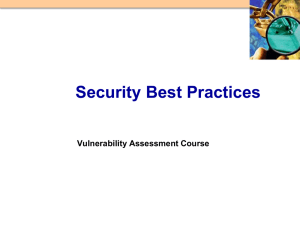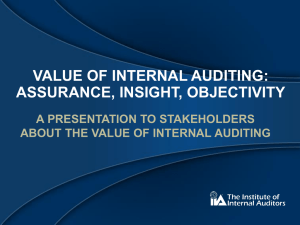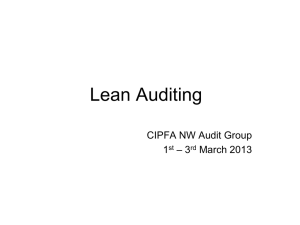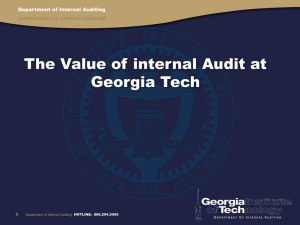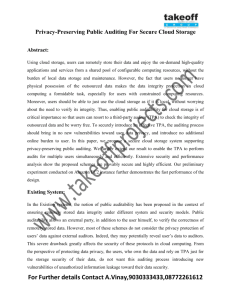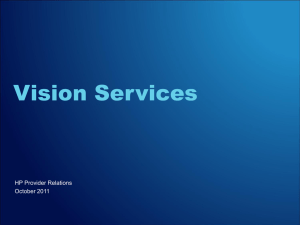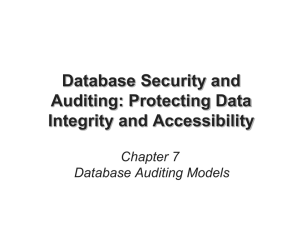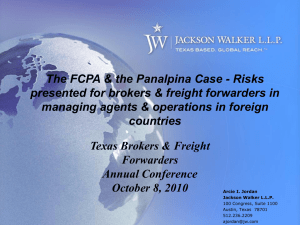Here - The Conflict of Interest Blog
advertisement
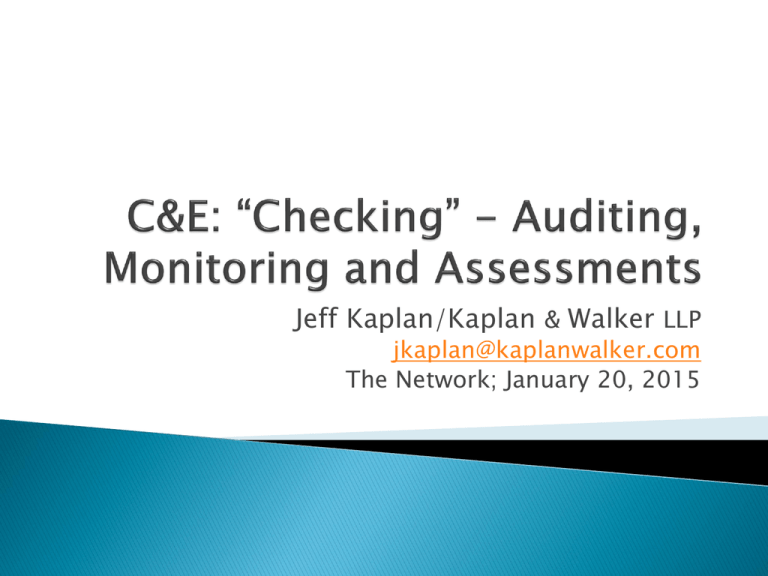
Jeff Kaplan/Kaplan & Walker LLP jkaplan@kaplanwalker.com The Network; January 20, 2015 Auditing Monitoring ◦ But not all the uses of technology Through two different lenses ◦ General program ◦ Different risk areas (e.g., anti-corruption) Assessments: risk, program and culture Relevance of “behavioral ethics” to checking www.kaplanwalker.com 2 Official expectations ◦ Auditing and monitoring have always been particularly important to the government 1992 Antitrust Division statement The 2010 compliance “half measures” FCPA case As programs mature, promoting understanding (through policies and training) should become relatively less of a focus and ensuring actual compliance (through auditing and monitoring) become more of one www.kaplanwalker.com 3 Auditing and monitoring are particularly important for ◦ Global/highly dispersed companies ◦ Those in highly regulated industries ◦ Companies with cultural challenge www.kaplanwalker.com 4 Relationships between relevant C&E categories can be confusing E.g., ◦ Auditing can overlap with program assessment, and with risk assessment ◦ The line between auditing and investigations is not always well marked ◦ Monitoring can overlap with governance and management ◦ Metrics are part of monitoring, but are sometimes discussed separately www.kaplanwalker.com 5 ◦ Encouraging reports of suspected violations can be seen as a form of monitoring – but is generally treated as a different animal ◦ Other types of internal controls (e.g., preapprovals) can also be viewed as a form of monitoring – but really serve a different function Does this matter? It can – if people are talking past each other www.kaplanwalker.com 6 The big picture is important – but so is the small one ◦ Companies generally should be moving in the direction of “nano compliance” Location or risk area specific Learning to paint with a narrow brush ◦ Monitoring in particular is a useful vehicle for this www.kaplanwalker.com 7 Differs from auditing in that it is ◦ Less independent ◦ More real time Generally, an under-utilized C&E function Covers a lot of ground, but a major distinction is between monitoring by ◦ Business people – both risk area and general program ◦ Non-audit staff www.kaplanwalker.com 8 Often called “the first line of defense” The most immediate – and least independent –form of C&E checking Risk-area examples include tasking managers to ◦ T&E reviews by direct supervisors ◦ Review of invoices of third parties for any indicia of corruption (or violation of other rules) ◦ Review pricing and other activities for any indicia of antitrust violations ◦ Monitoring COIs that have been conditionally okayed www.kaplanwalker.com 9 Challenges to risk area monitoring ◦ Is it informed? ◦ Is it documented? ◦ Is it actually happening? Note that this type of monitoring is often part of larger business monitoring ◦ E.g., of high-risk agents (making sure not only that they are acting properly but that they are doing what you want/pay them to do) www.kaplanwalker.com 10 General program monitoring ◦ Ensuring that employees in the manager’s BU have taken required training ◦ Seeing how lower level managers communicate about C&E to their subordinates Other points about monitoring ◦ Serves to educate business people (learn by doing) ◦ Provides a predicate for C&E-based compensation “Supervisory liability” (meaning internal, not actual legal, accountability) www.kaplanwalker.com 11 Business people at my company do enough monitoring by: ◦ ◦ ◦ ◦ both risk area and overall program just risk area just overall program neither risk area nor overall program www.kaplanwalker.com 12 These include ◦ ◦ ◦ ◦ ◦ ◦ ◦ Finance Legal HR IS EH&S Security C&E They are seen as non-independent because they may be reviewing their own work This is “the second line of defense” www.kaplanwalker.com 13 Anti-corruption ◦ Periodic controls reviews by Finance ◦ C&E reviewing gift registers and third party due diligence files Competition law: Legal department reviewing sales files Employment: ◦ Looking for required postings ◦ Reviewing personnel files EH&S: many examples Risk-area specific ◦ Life sciences “ride-alongs” ◦ Review of trading at financial service firms www.kaplanwalker.com 14 Looking at ◦ ◦ ◦ ◦ ◦ Training and communications C&E concerns reporting Investigations and discipline Hiring and incentives Mostly by the C&E office, but not exclusively Two other forms of checking that are monitoring like ◦ C&E questions in employee engagement survey ◦ C&E questions in exit interviews www.kaplanwalker.com 15 Staff at my company do enough monitoring by: ◦ ◦ ◦ ◦ both risk area and overall program just risk area just overall program neither risk area nor overall program www.kaplanwalker.com 16 A self check tool (consider adding a geographic and/or product/service line to the tool) ◦ It would include both business personnel and staff monitoring ◦ A note on “nature of the risk” Area of law Nature of risk Current monitoring Monitoring to consider adding FCPA Antitrust etc. www.kaplanwalker.com 17 The “third line of defense” More independent and less frequent than monitoring Includes both internal and external C&E audits are ◦ Sometimes stand-alone ◦ More often part of broader audits Does having C&E part of audit planning process pose an independence problem? www.kaplanwalker.com 18 Risk areas commonly audited ◦ ◦ ◦ ◦ ◦ ◦ FCPA Fraud Privacy IP/confidential information Trade controls Industry-specific regulated areas Many others Sometimes stand-alone, more often as part of more general audits www.kaplanwalker.com 19 General program ◦ C&E reporting and investigations Flows from Caremark/Stone v Ritter ◦ Employee knowledge of program requirements ◦ Auditing against governance requirements E.g., regional committees A good reason to have charters www.kaplanwalker.com 20 Ensuring sufficient domain knowledge by auditors Ensuring follow up Should audit results be a metric? ◦ The danger: creating incentives to game the system Can Audit serve in other C&E roles? ◦ Depends on how much These roles involve exercise of judgment You want to audit the roles ◦ Training, investigations generally okay – designing controls a closer call www.kaplanwalker.com 21 My company does enough compliance auditing by: ◦ ◦ ◦ ◦ both risk area and overall program just risk area just overall program neither risk area nor overall program www.kaplanwalker.com 22 Assessments are generally more qualitative than audits Here too there are many variations Will describe six general types ◦ Actual assessments typically are a blend of more than one of these – rarely are they stand-alone ◦ Hopefully this will help you do a needs assessment for your program, risk and culture assessments www.kaplanwalker.com 23 Risk areas that are the primary responsibility of the C&E office and that are both broad (meaning they touch many employees) and deep (meaning they have a potentially high impact) – e.g., corruption, competition law and possibly fraud ◦ Be mindful of particular expectations for anticorruption risk assessments ◦ Don’t neglect competition law New official expectations from Italian government www.kaplanwalker.com 24 Risk areas that are the primary responsibility of the C&E office but are not so broad and/or deep ◦ In some companies, conflicts of interest (often broad, but not that deep) or insider trading (deep, but not typically that broad) fit into this category ◦ Part of the assessment regarding confidential information will depend partly on how important such information is to a company) ◦ You should generally cover these in assessments – but not necessarily to the same degree as type 1 risks www.kaplanwalker.com 25 Risk areas that may be broad and deep, but that are the primary responsibility of another function at the company ◦ In some companies, trade compliance or employment law would fit this bill ◦ One might have a narrower gauge of inquiry in the interviews/document reviews, at least if such functions have already conducted some form of targeted assessment(s) regarding these risks ◦ A good area for awareness questions www.kaplanwalker.com 26 Program assessment: tools/elements about which many employees typically have information/views ◦ Examples include C&E training and the helpline Most assessments include this, but how much to focus on it depends on various factors ◦ E.g., getting a wide array of feedback on training will make sense if you are considering overhauling your training ◦ Helpline/investigation assessments particularly important for public companies due to Caremark www.kaplanwalker.com 27 Tools/elements that relatively few employees have information/views about Examples include ◦ Monitoring approaches ◦ Pre-hiring due diligence ◦ Board oversight Need to cover, but often in different ways than type 1 assessment topics www.kaplanwalker.com 28 Relevant to both program and risk assessment ◦ But for planning purposes generally should be viewed as its own effort): factors that could impact both the degree of risk and the efficacy of the program ◦ Examples include tone at the top, accountability, openness of communication and alignment of rewards with stated C&E values ◦ Not just organizational cultures – but geographic and industry ones too How deep should you dive? ◦ Depends on contemplated use of assessment ◦ Boards of directors tend to care particularly about these sorts of assessments – because culture is where they can help www.kaplanwalker.com 29 Knowledge/ideas from behavioral economics applied to ethics Overriding lesson: we are not as ethical as we think ◦ Can help to explain results of checking in ways that promote greater C&E efforts generally For more specific lessons for risk assessment and other C&E functions (particularly training) see www.conflictofinterestblog.com under Interests – Bias tab www.kaplanwalker.com 30 And, thank you for attending the web cast! www.kaplanwalker.com 31


